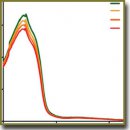
Development of Nanosecond Laser Module Built in the Robotic Multifunctional Surgical Complex for Minimally Invasive Therapy of Maxillofacial Area Pathology and Estimation of Its Effects on Blood Plasma
The aim of the investigation was to assess the efficiency of singlet oxygen excitation in blood plasma in vitro using infrared laser radiation with 1260±4 nm wavelength generated by a pulsed laser module, which was designed to be built in the robotic surgical device for minimally invasive maxillofacial surgery.
Materials and Methods. The model of the developed nanosecond laser (1,260±4 nm wavelength) generating pulse signal with 400 ns pulse duration, 500 kHz pulse repetition frequency, and 500 μm optic fiber diameter was used in the investigation. Test tubes with heparin sodium having various centrifuging time served for obtaining blood plasma. Three blood plasma specimens obtained in different centrifuging modes were used in the study. Photochemical measurements were performed in blood plasma diluted with a neutral (pH 7.6) phosphate buffer. The reaction of releasing singlet oxygen was controlled by discoloration with the help of a spectrophotometer under laser radiation of the main band of the trap.
Results. The reduction of optical density at 414 nm spectrophotometer wavelength was significantly noted in all three specimens, the effect amounted to 0.04±0.01 over 30 min of radiation. When buffer diluted blood plasma was exposed to the tested infrared laser during 1.5 h, the significant effect of the trap discoloration was observed in all specimens. Laser radiation in the nanosecond pulse mode provided discoloration 10 times greater than that of the laser working in the continuous mode.
Conclusion. The experiments performed showed that the application of the original nanosecond pulsed laser module provided effective generation of singlet oxygen. Small dimensions and unique characteristics allow the module to be built in the robotic surgical complex.
- Lehnert M.W. Lasers in medicine and dentistry. Northwest Dent 1996; 75(1): 17–22.
- Goonewardene S.S., Persad R. Robotic radical prostatectomy, day-case surgery and cardiac health: an opposing paradigm? J Robot Surg 2015, 9(4): 355, https://doi.org/10.1007/s11701-015-0537-9.
- Propedevticheskaya stomatologiya [Propaedeutic dentistry]. Pod red. Bazikyana E.A. [Bazikyan E.A. (editor)]. Moscow: GEOTAR-Media, 2008; 768 р.
- Borisenko G.G., Lukina G.I., Bazikyan E.A., Kovaleva A.M. Assessment of morphological changes in oral mucosa in patients with gastrointestinal pathology. Klinicheskaya meditsina 2009; 87(6): 36–38.
- Krasnovsky A.A. Jr., Drozdova N.N., Roumbal Ya.V., Ivanov A.V., Ambartzumian R.V. Biophotonics of molecular oxygen: activation efficiencies upon direct and photosensitized excitation. Chin Opt Lett 2005; 3: S1–S4.
- He G.S., Lin T.-C., Dai J., Prasad P.N., Kannan R., Dombroskie A.G., Vaia R.A., Tan L.-S. Degenerate two-photon-absorption spectral studies of highly two-photon active organic chromophores. J Chem Phys 2004; 120(11): 5275, https://doi.org/10.1063/1.1647537.
- Chunikhin A.A., Bazikyan E.A., Krasnovsky A.A., Syrnikova N.V., Chobanyan A.G. The prospects for the improvement of the minimally invasive laser technologies for the photodynamic treatment of dental pathologies. Rossiiskaya stomatologiya 2015; 8(2): 70–74, https://doi.org/10.17116/rosstomat20158271-74.










